AMD Radeon HD 7990 Review: 7990 Gets Official
by Ryan Smith on April 24, 2013 12:01 AM EST- Posted in
- GPUs
- AMD
- Radeon
- Radeon HD 7000
- Tahiti
Sleeping Dogs
Another Square Enix game, Sleeping Dogs is one of the few open world games to be released with any kind of benchmark, giving us a unique opportunity to benchmark an open world game. Like most console ports, Sleeping Dogs’ base assets are not extremely demanding, but it makes up for it with its interesting anti-aliasing implementation, a mix of FXAA and SSAA that at its highest settings does an impeccable job of removing jaggies. However by effectively rendering the game world multiple times over, it can also require a very powerful video card to drive these high AA modes.
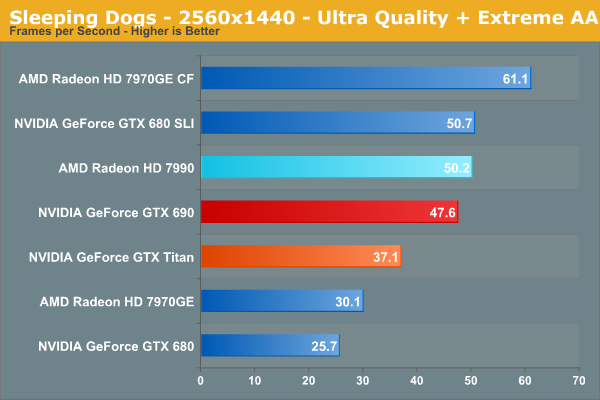
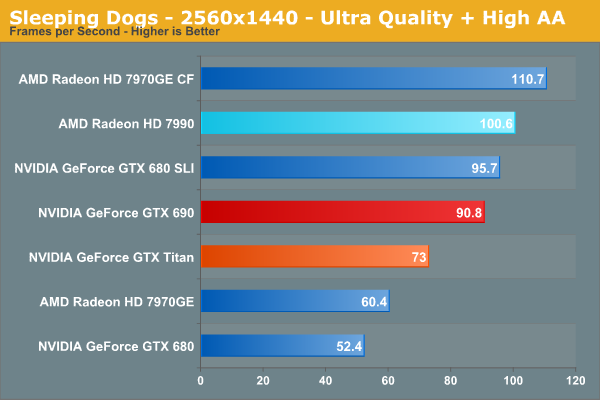
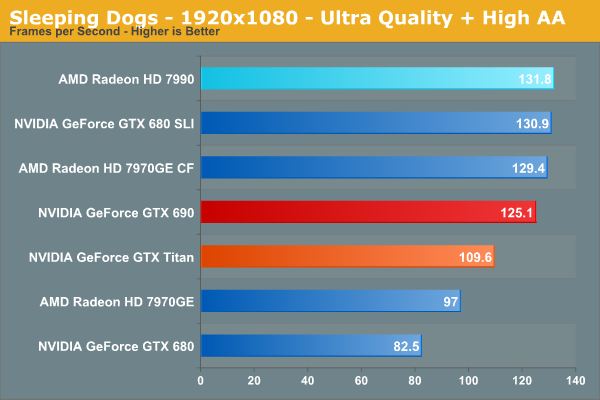
Sleeping Dogs is one of the games targeted by NVIDIA’s latest driver update, and as a result the performance gap between AMD and NVIDIA setups has narrowed since when we first started using it. Ultimately this is still a game that AMD does better at, and the 7990 is always ahead of the GTX 690 by at least a few frames per second, never mind the much greater lead over Titan. We generally value single-GPU cards for their consistency, but in times like these Titan pays heavily for it compared to the likes of the 7990.
Meanwhile at 5760 we’re once again seeing the 7990 trail the 7970GE CF by quite a large degree; the gap is now 18%. So at the highest and most demanding settings there is still a clear performance advantage for two-card CrossFire setups, as we’re seeing here.
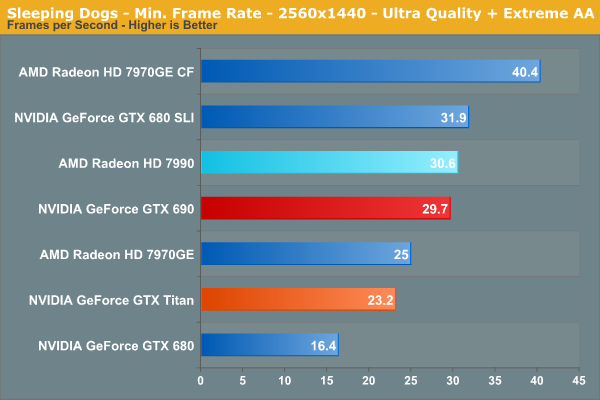
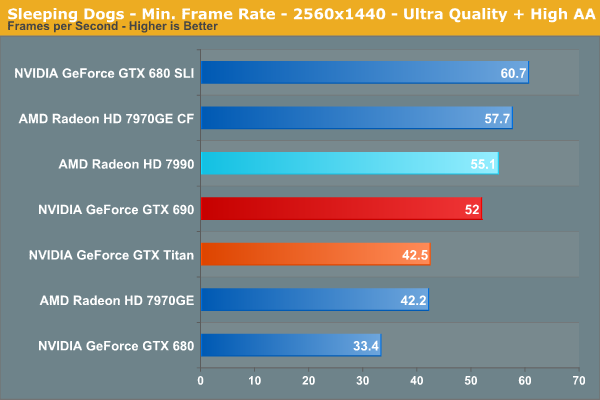
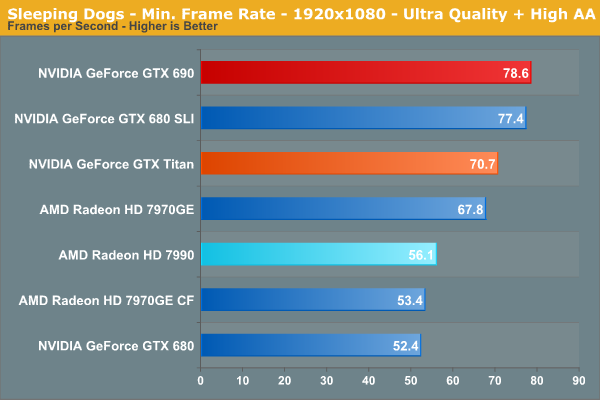
Something about Sleeping Dogs at lower resolutions holds back AMD CF setups, which means the 7990 gets impacted here too. 55fps is reasonable enough for playability purposes, but this is a good example of why multi-GPU scaling isn’t an infallible solution.










91 Comments
View All Comments
HisDivineOrder - Wednesday, April 24, 2013 - link
They bring a fantastic cooler that prioritizes silence and convenience to have SLI in a system that doesn't have two PCIe slots available for them. Plus, you always had the option of quad-SLI that's a little harder to do with four 680's.That said, I think anyone buying a 690 over a Titan now is pretty stupid. It's not about the speed difference. It's that if you're in the market for a $1k GPU, go for the one that won't be running out of memory with next year's PS4/next Xbox ports.
extremesheep - Wednesday, April 24, 2013 - link
Table typo...should the first be "7990"?extremesheep - Wednesday, April 24, 2013 - link
Err...should page 1, table 1, column 1 be "7990" instead of "7970"?Ryan Smith - Wednesday, April 24, 2013 - link
You may be seeing an old, cached copy. That was fixed about 25 minutes ago.code65536 - Wednesday, April 24, 2013 - link
Any chance we could get Tomb Raider in future benchmark tests?Ryan Smith - Wednesday, April 24, 2013 - link
In the desktop tests? No. We keep the tests capped at 10 so that it's a manageable load when we need to redo everything, such as with the 7990 launch. At this point the desktop benchmark suite is set for at least the immediate future.VulgarDisplay - Wednesday, April 24, 2013 - link
4th paragraph: Incorrectly stated that Tahiti has 48 rops.Flamencor - Wednesday, April 24, 2013 - link
What a mediocre review! In your conclusions, you mention nothing about how AMD absolutely spanked NVIDIA in compute performance and synthetics! It is 75 watts more power hungry, and in exchange you get substantially more memory and a total win on compute and synthetics! I know synthetics aren't actual gaming numbers, but they're indicative of how the card will stand up to future games. The fact that the card has far better synthetics says a lot about it's longevity. The card looks like a great card (although quite late)! I'm no fanboy, but why can't people just write a legitimately upbeat and positive review about an amazing part?Warren21 - Wednesday, April 24, 2013 - link
Ryan typically has a slight undertone of NVIDIA bias; it can be found in most of his articles. That being said, the GTX 600 series are some amazing cards. I'd love to have a GK104-based card to replace my aged 6870 1GB.CiccioB - Wednesday, April 24, 2013 - link
This kind of compute benchmarks based on OpenCL are quite useless. No professional applications use OpenCL and nvidia doesn't really put all its efforts in optimizing their OpenCL drivers.You may be surprise to know that REAL applications that really need GPU assisted computation use CUDA. And thus you have the option to use nvidia GPU computation or nothing else.
That's for how good is OpenCL. It may be open, it may be something AMD needs to show good (useless) graphs, but in real word none is going to use it for serious stuff.
3D renderers are a meaningful example: apart the useless SmallLuxMark benchmark, professional engines use CUDA. AMD is not there with whatever "devasting" computational solution you may believe they have. That's why nvidia holds more than 80% of the professional market and it's the only one having GPUs solutions for HPC while AMD just struggles to sell consumer products.
By the way, goo review, though a double Titan solution may have been added to make it more interesting (especially for power consumption) :)